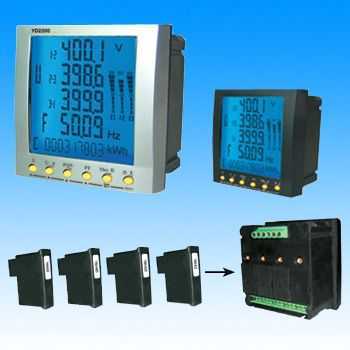
In recent years, the development of intelligent measurement and control instruments has been particularly rapid. A variety of intelligent measurement and control instruments have appeared in the domestic market. For example, intelligent throttle flowmeters capable of automatic differential pressure compensation, intelligent multi-stage temperature controllers capable of temperature control, and digital PIDs Smart regulators for complex control laws, and intelligent chromatographs that can analyze and process various spectra.
There are many kinds of intelligent measuring instruments in the world. For example, the dstj-3000 series of smart transmitters manufactured by Honeywell, USA, can carry out composite measurement of differential pressure status, and can automatically realize the temperature and static pressure of the transmitter body. Compensation, the accuracy can reach 0.1% fs; US Racat-dana 9303 ultra-high-level meter, the use of microprocessors to eliminate the thermal noise generated by the current flowing through the resistor, the measurement level can be as low as -77db; United States fluke The company's super-multifunctional calibrator 5520a uses 3 microprocessors internally. Its short-term stability is 1ppm and its linearity can reach 0.5ppm. The digital self-adjusting regulator manufactured by Foxboro Inc. uses expert system technology. The regulator can be quickly adjusted based on field parameters just like an experienced control engineer. This regulator is particularly suitable for control systems where the object changes frequently or non-linearly. Because this regulator can automatically adjust the adjustment parameters, the entire system can always maintain the best quality in the production process.
Intelligent Instrumentation Development Trends Miniaturized Micro-intelligent instruments refer to microelectronics, micro-mechanics, and information technology that have been integrated into the production of instruments, making the instrument a small, full-featured intelligent instrument. It can complete signal acquisition, linearization, digital signal processing, control signal output, amplification, interface with other instruments, and human interaction. With the continuous development of micro-electro-mechanical technology, micro-intelligent instruments, their technologies continue to mature, prices continue to decline, so their application areas will continue to expand. It not only has the functions of traditional instruments, but also can play a unique role in the fields of automation technology, aerospace, military, biotechnology, and medical care. For example, it is currently necessary to measure several different parameters of a patient at the same time and perform control of certain parameters. Usually the patient's body is inserted into several tubes, which increases the chance of patient infection. Micro-intelligent instruments can measure multiple parameters at the same time. And it is small and implantable in the human body, making these problems solved.
Multifunctional multifunction is a feature of smart instrumentation. For example, in order to design faster and more complex digital systems, instrument manufacturers have created function generators with functions such as pulse generators, frequency synthesizers, and arbitrary waveform generators. This versatile integrated product not only offers higher performance (eg, accuracy) than dedicated pulse generators and frequency synthesizers, but also provides a better solution for various test functions.
Artificial intelligence artificial intelligence is a new field of computer applications. It uses computer to simulate human intelligence and is used in robots, medical diagnosis, expert systems, and proof of reasoning.
The further development of smart devices will contain certain artificial intelligence, which replaces part of the human brain work, and thus in the visual (graphics and color recognition), hearing (speech recognition and language understanding), thinking (reasoning, judgment, learning and association) Other aspects have a certain ability.
In this way, smart devices can autonomously perform detection or control functions without human intervention. Obviously, the application of artificial intelligence in modern instrumentation allows us not only to solve a class of problems that are difficult to solve with traditional methods, but also to solve the problems that cannot be solved by traditional methods.
Integrate isp and emit technologies to achieve internet access for instrumentation systems (networking)
With the rapid development of network technology, internet technology is gradually infiltrating into the field of industrial control and intelligent instrumentation system design. The intelligent instrumentation system is based on internet-based communication capabilities and remotely upgraded and functionally-redesigned intelligent instrumentation systems. And system maintenance.
In-system programming (iSP) is a state-of-the-art technology that modifies, configures, or restructures software. It is a kind of first proposed by lattice semiconductor company that allows us to carry out every link in the product design and manufacturing process, and even after the product is sold to end users, it has the logic and function of its devices, circuit boards or the entire electronic system at any time. The latest technology for configuration or reorganization capabilities. The isp technology eliminates some of the limitations of traditional technologies and connection flaws, and is conducive to board design, manufacturing, and programming. Isp hardware is flexible and easy to modify software to facilitate design and development. Since isp devices can be handled on a printed circuit board (pcb) like any other device, programming isp devices do not require specialized programmers and more complex processes, as long as they are performed via a PC, an embedded system processor, or even an internet remote network. Programming.
The embedded micro-internet Internet connection technology was proposed by Emware Corporation when it created the eti (extend the internet) expansion of the internet alliance. It is a technology for accessing embedded devices such as SCMs to the internet. Using this technology, it is possible to connect 8-bit and 16-bit microcomputer systems to the internet to implement remote-based data acquisition, intelligent control, and upload/download of data files.
At present, the United States, connectone, emware, tapeking, and domestic ps companies provide internet-based devic.
Industrial Round Pipe Aluminum Profile
Industrial Round Pipe Aluminum Profile,Round Aluminum Extrusion Profiles,Aluminium Round Profile,Round Aluminum Profile
Wuqiang Xingdou International Trade Co., Ltd , https://www.xdaluminum.com